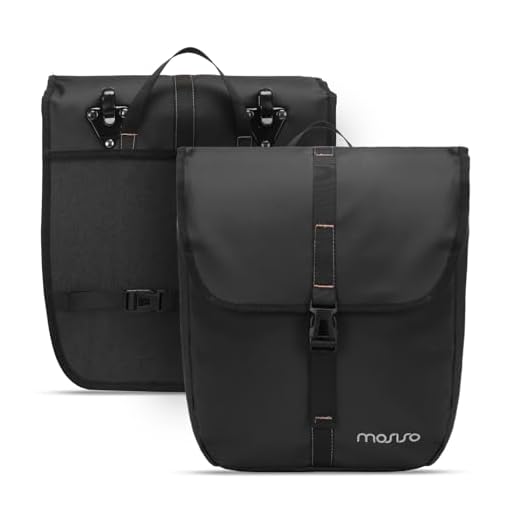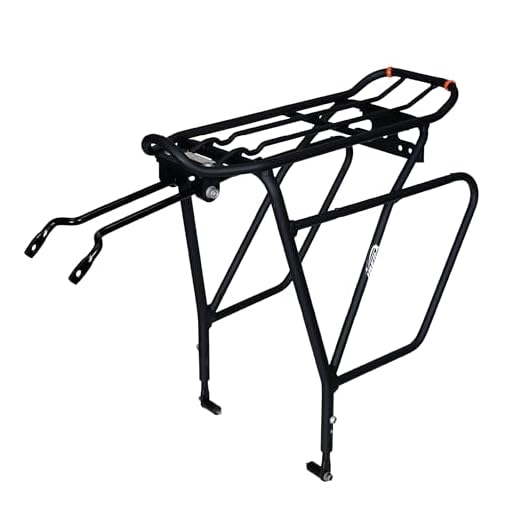



Prioritize a reliable and sturdy rear rack as the backbone of your setup. This component can support bags designed specifically for cycling, ensuring weight distribution for stability as you cover miles. Look for options with adjustable mounting to fit various bike frames securely.
Utilize waterproof panniers or dry bags to shield your belongings from inclement weather. Investing in high-quality, durable waterproof gear will keep essentials dry and protected against the elements, resulting in a hassle-free experience regardless of conditions.
Consider packing light and smart. Select versatile clothing and multi-purpose tools to reduce overall weight. Organize items into categories–such as clothing, tools, and personal items–using compression sacks or packing cubes to maximize space and maintain order during your adventure.
Incorporate a lightweight sleeping system that accommodates both comfort and packability. A compact sleeping bag and inflatable sleeping pad can significantly enhance overnight rest, making long days on the trail more enjoyable.
Familiarize yourself with the route beforehand, noting facilities for refueling and lodging. Understanding the logistics of where you can restock supplies will minimize the amount you need to carry daily, lightening the load and enhancing your overall experience.
Transport Tips for Your Gear during the Event
Utilize a high-quality pannier system for optimal carrying capacity. Choose models with waterproof features to protect your items against rain. Distribute weight evenly across both sides of your ride to maintain balance, placing heavier items closer to the frame.
Using a Trailer
If you require additional space, consider a lightweight trailer. Ensure it’s compatible with your setup and has a secure attachment. Track your trailer’s load; limit bulk to prevent straining your bicycle’s frame. Regularly check connections and wheel stability during stops.
Pack Smartly
Organize essentials in separate bags for easy access. Use packing cubes or compression sacks to maximize space. Remember to pack tools and repair kits in easily reachable pockets in case of emergencies. Roll clothing instead of folding to save additional space and reduce wrinkles.
Choosing the Right Luggage for Your Bike Tour
Select lightweight options that complement your cycling experience. Prioritize durability and weather resistance to protect contents against elements. Look for models with quick-release systems for easy loading and unloading.
Types of Luggage Solutions
| Type | Description | Advantages |
|---|---|---|
| Panniers | Attach to bike racks, providing balanced weight distribution. | Stable, easy to access, can carry heavy items. |
| Backpacks | Worn on the cyclist’s back, suitable for smaller loads. | Versatile, allows for quick access, useful off the bike. |
| Frame Bags | Fit snugly within the bike’s frame, ideal for tools and essentials. | Low center of gravity, unobtrusive, maximizes space. |
| Saddle Bags | Small packs that attach under the saddle for minimal storage. | Lightweight, keeps essentials accessible, good for short trips. |
Capacity and Organization
Choose sizes based on trip length. Use packing cubes or compression sacks for organization, facilitating easy access to items. A modular approach allows flexibility in adjusting space as needed.
Best Methods for Securing Luggage to Your Bike
Utilize a quality rack specifically designed for mounting atop your cycle. Make sure it’s compatible with your frame and provides adequate support. Choose suspension components to absorb shocks and vibrations during your rides.
Employ adjustable straps or bungee cords to firmly attach bags. Ensure these are made from durable materials capable of withstanding different weather conditions. Position items in a way that evenly distributes weight, preventing instability.
Consider using waterproof panniers for safeguarding contents from moisture. Many options offer extra reflective strips for visibility, enhancing safety during rides.
Use a locking system, such as a cable lock, to secure the main bag. This minimizes risk while stopping for breaks. Always test the fastening mechanisms before departure to ensure items remain intact throughout the route.
Utilize clips or hooks for quick-release options, allowing for rapid access to essentials. This feature promotes convenience during rest stops without the need for constant removal and reattachment.
Regularly check and adjust all connections and fasteners throughout your adventure, especially after rough terrain. Preventive maintenance ensures everything remains secure and functional during travel.
Essential Gear for Packing Light and Smart
Utilize compact, multi-functional items to minimize space. Choose a sleeping bag that compresses easily and is suitable for various weather conditions, allowing you to save on bulk. Invest in clothing that dries quickly and can be layered, ensuring adaptability to changing temperatures.
Smart Packing Techniques
Roll clothing instead of folding; this saves space and helps reduce wrinkles. Use packing cubes or compression sacks for organization, separating items into categories for easy access. Prioritize lightweight accessories like a travel towel that dries swiftly and packs small.
Consider Quality Gear
Opt for durable materials that can withstand wear and tear without adding excessive weight. Select a reliable waterproof bag for important electronics and essentials. For those flying, research options for the best luggage for aircrew to ensure your gear is suitable for travel.
Tips for Navigating Different Terrain with Luggage
Choose a reliable bike equipped with appropriate gearing to tackle various surfaces. A bike with lower gear ratios provides better control on steep inclines and rough paths.
Adjust your load distribution for stability by positioning heavier items closer to the center of the frame. This approach reduces the center of gravity and enhances balance.
- Utilize wider tires with a tread suitable for each environment. They offer increased grip on loose gravel and muddy trails.
- Consider using a suspension to smooth out bumps and ensure a comfortable ride on uneven surfaces.
- Keep your items secured with high-quality ties or straps, especially when traversing rocky terrain.
When approaching steep descents, shift your weight back to prevent the front wheel from lifting. Practice this maneuver during training sessions for improved confidence.
On sandy or loose soils, maintain a steady pace to avoid getting bogged down. Stand up on the pedals for better traction and maneuverability.
Investigate potential routes in advance to identify challenging sections. Marking these on a map can help plan for breaks or gear adjustments.
Stay hydrated and carry a compact toolkit for quick fixes. Incorporating lightweight solar-powered accessories, such as the best choice products solar led lighted patio umbrella, can enhance your visibility during nighttime riding.
Regularly check your equipment and setup throughout the trip to ensure everything remains secure and functional as conditions change.
Strategies for Maintaining Balance While Riding Loaded
Center weight distribution over the frame for improved stability. Position heaviest items low and close to the bike’s centerline. This reduces the risk of tipping and enhances control.
Adjust tire pressure based on the added weight. A slightly lower pressure can increase surface contact, providing better grip and balance on uneven surfaces.
Utilize wide handlebars for added leverage. This allows for finer steering adjustments, particularly important with additional cargo.
Practice shifting your body weight. Lean into turns and shift your hips forward while ascending or accelerating, which helps maintain equilibrium.
Engage your core muscles. Stronger core stability translates to better balance and control, especially during sudden maneuvers.
Take turns slowly. Reducing speed while cornering helps manage the weight’s influence and minimizes the likelihood of losing control.
Familiarize yourself with the loaded bike’s handling. Spend time riding in a safe area to adapt to the altered dynamics before hitting more challenging routes.
Keep an eye on your speed. Maintaining a steady pace aids in controlling handling, reducing the risk of abrupt shifts in weight.
Make use of visual cues. Focus on where you want to go rather than the ground immediately in front of you, which can help maintain a steady trajectory.
Managing Weather and Environmental Conditions During the Tour
Carry a compact weatherproof jacket and lightweight rain pants to handle unexpected showers. Assess what’s forecasted before heading out, allowing adjustments to plans when necessary. A packable windbreaker can also aid in maintaining body temperature during chilly mornings or windy stretches.
Sun Protection and Hydration
Apply sunscreen with a high SPF on exposed skin, and don a wide-brimmed hat to shield against UV rays. Don’t forget sunglasses with UV protection. Staying hydrated is critical; drink water regularly and consider packing electrolyte supplements for hot days. Utilizing a hydration pack is an excellent option to ensure consistent access to fluids.
Adapting to Terrain and Conditions
Monitor trail conditions and be ready to adjust routes depending on weather impacts. If rainfall has made paths muddy, opt for nearby paved roads if available. Investing in durable tires suited for various surfaces can enhance performance in slippery or soft conditions. For photography enthusiasts, consider referencing a best digital camera compare site to ensure your gear captures the moment, even in less than ideal weather.









